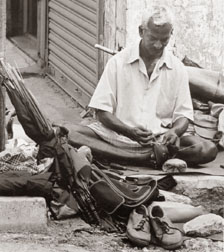|
observer |
|
|
|
|
|
OTHER LINKS |

|

|

|
Colombo CobblerRoadside cobblers are a special feature of Sri Lankan cities, with some of them even traversing residential streets, offering a one-of-a-kind home cobbler service. I decided to find out more about this unique trade, so I went looking for a cobbler and met K P Subramani who has been a roadside cobbler for the past 25 years.
Sitting on the pavement under a temporary shed that he put up at the beginning, he starts his daily routine surrounded by an assortment of odds and ends like tools, old umbrellas, pieces of wire, old shoes etc. First up is the tool kit as we all know having the right tools is essential for the success of any trade, and this one is no different. Unique to this profession are the tools that are made by the cobbler himself, using old metal, wood and other discarded objects found on the streets. After getting the tools ready, he invited me to watch while he repairs a shoe. The sole of this particular shoe had come off and had to be removed completely. Then a nylon thread was run through a ball of wax. I was told that this is done to make the thread stronger, more pliable, and to increase its durability. The sole is then stitches by making incisions in the shoe using the needle. Once the entire sole is stitched a complicated array of knots are performed to hold the stitched in place. Finally, the remaining thread is cut using a unique cutting tool. Next up is the price, although there is no uniform price it is decided only after a careful inspection of the repair item. Haggling over the price is allowed, but often proves to be futile. Roadside cobblers know the fine art of justifying their pricing structure, and argue their case with dogged eloquence. Besides the tiring effort of counter-arguments, the cobbler's hand-done repairs are usually worth the price. According to Subramani, the quality of their work is perceived to be better than its mechanical equivalent because they sew with a nylon thread, which is strong and long lasting. On a typical day the cobbler repairs about 10 pairs of shoes and ideally takes between 10-30 minutes for a single repair, depending on the level of wear and tear. The polishing of shoes is another popular service. It takes around 15 minutes to polish a pair of shoes and attention is given not just to the polishing but also to enriching the texture and quality of the shoes. Once the polish is applied, the shoe is briefly sun-dried and given a good shine with a cloth. I was somewhat dishertended to learn that he does not want his children carrying on this trade. The reason being that he has not been able to shift from the temporary shed he started this trade in and has not seen an improvement in his standard for living. Therefore, he says, "I hope that my children will find a better quality of life by doing another job". With that I bid good-bye to Subramani. Walking away, I could not help but feel a sense of nostalgia for the future generations, who will probably never have an experience of a traditional Sri Lankan shoe repair and also for the considerable amount of knowledge that will now not be passed down. |
 Hailing from a family of five, he learnt this craft from his brothers
who have now given up. But he continues, because this is the only trade
known to him and uses it to survive and support his family. Travelling
from Kirullapone he often starts work at 8.00 a.m. and carries on till
dusk repairing items such as umbrellas, shoes and bags.
Hailing from a family of five, he learnt this craft from his brothers
who have now given up. But he continues, because this is the only trade
known to him and uses it to survive and support his family. Travelling
from Kirullapone he often starts work at 8.00 a.m. and carries on till
dusk repairing items such as umbrellas, shoes and bags. 







